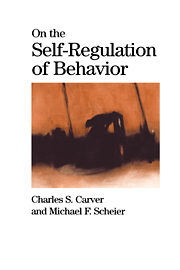Book contents
- Frontmatter
- Contents
- Preface
- Acknowledgments
- 1 Introduction and Plan
- 2 Principles of Feedback Control
- 3 Discrepancy-Reducing Feedback Processes in Behavior
- 4 Discrepancy-Enlarging Loops, and Three Further Issues
- 5 Goals and Behavior
- 6 Goals, Hierarchicality, and Behavior: Further Issues
- 7 Public and Private Aspects of the Self
- 8 Control Processes and Affect
- 9 Affect: Issues and Comparisons
- 10 Expectancies and Disengagement
- 11 Disengagement: Issues and Comparisons
- 12 Applications to Problems in Living
- 13 Hierarchicality and Problems in Living
- 14 Chaos and Dynamic Systems
- 15 Catastrophe Theory
- 16 Further Applications to Problems in Living
- 17 Is Behavior Controlled or Does It Emerge?
- 18 Goal Engagement, Life, and Death
- References
- Name Index
- Subject Index
4 - Discrepancy-Enlarging Loops, and Three Further Issues
Published online by Cambridge University Press: 05 June 2012
- Frontmatter
- Contents
- Preface
- Acknowledgments
- 1 Introduction and Plan
- 2 Principles of Feedback Control
- 3 Discrepancy-Reducing Feedback Processes in Behavior
- 4 Discrepancy-Enlarging Loops, and Three Further Issues
- 5 Goals and Behavior
- 6 Goals, Hierarchicality, and Behavior: Further Issues
- 7 Public and Private Aspects of the Self
- 8 Control Processes and Affect
- 9 Affect: Issues and Comparisons
- 10 Expectancies and Disengagement
- 11 Disengagement: Issues and Comparisons
- 12 Applications to Problems in Living
- 13 Hierarchicality and Problems in Living
- 14 Chaos and Dynamic Systems
- 15 Catastrophe Theory
- 16 Further Applications to Problems in Living
- 17 Is Behavior Controlled or Does It Emerge?
- 18 Goal Engagement, Life, and Death
- References
- Name Index
- Subject Index
Summary
In Chapter 3 we talked about efforts to conform to behavioral reference points. Those processes cover a lot of behavior, but not all behavior. Sometimes people want to attain particular ends, but sometimes they want to escape or avoid particular ends. Sometimes people want to be specific ways, sometimes they want to not be specific ways. The experiences of trying to move toward and trying to move away obviously differ, and they involve different self-regulatory structures.
In this chapter we consider moving-away processes, and a different kind of feedback loop: the discrepancy-enlarging loop. As we said in Chapter 2, some feedback processes act to create a divergence between an input (perception of present condition) and a comparison value. Rather than resembling a gravity field, it looks like antigravity. Rather than a goal, it seems to involve an anti-goal. These loops may be less prominent in behavior than are approach loops. They do, however, play an important role. In this chapter we address that role. Then we turn to some broader questions that transcend the two types of feedback processes.
DISCREPANCY-ENLARGING FEEDBACK LOOPS IN BEHAVIOR
In trying to identify cases of positive feedback in behavior, there are several things to look for. First, positive loops always involve attempts to deviate from a comparison point, efforts to push away from something. Second, it's likely that the distancing from standard is constrained or overridden at some point by the action of a negative loop.
- Type
- Chapter
- Information
- On the Self-Regulation of Behavior , pp. 48 - 62Publisher: Cambridge University PressPrint publication year: 1998



